Global Wireless Charging for Electric Vehicles Market By Component, By Propulsion Type, By Charging Type, By Vehicle Type, By Installation Type, By Power Supply, By Region & Segmental Insights Trends and Forecast, 2024 – 2034
- Industry: Automotive & Transportation
- Report ID: TNR-110-1245
- Number of Pages: 420
- Table/Charts : Yes
- August, 2024
- Base Year : 2024
- No. of Companies : 10+
- No. of Countries : 29
- Views : 10052
- Covid Impact Covered: Yes
- War Impact Covered: Yes
- Formats : PDF, Excel, PPT
The global wireless charging market for electric vehicles (EVs) is experiencing significant growth, driven by increasing EV adoption, advancements in charging technology, and a push towards sustainable transportation solutions. Key trends include the development of dynamic wireless charging systems and the integration of artificial intelligence for optimized energy management.
Opportunities are emerging from government incentives, expanding charging infrastructure, and partnerships between automakers and technology firms. Additionally, the demand for convenient, efficient charging solutions in both residential and commercial settings is fostering innovation. As the automotive industry shifts towards electrification, wireless charging is poised to play a crucial role in enhancing user experience and supporting the global transition to a cleaner energy future. In terms of revenue, the global wireless charging for electric vehicles Market was worth US$ 83.7 Mn in 2023, anticipated to witness a CAGR of 49.5% during 2024 – 2034.
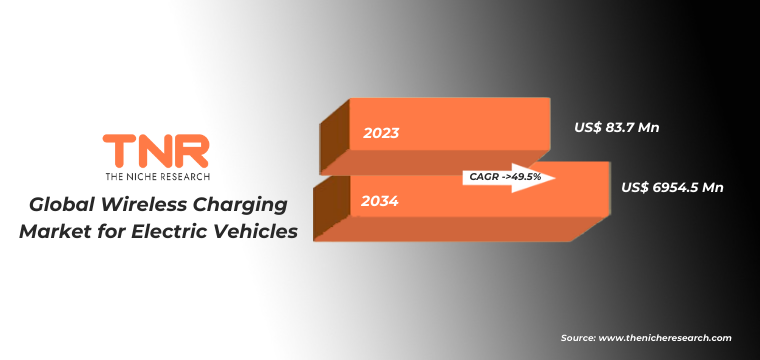
Global Wireless Charging for Electric Vehicles Market Dynamics
Global Wireless Charging for Electric Vehicles Market Growth Driver:
The global wireless charging market for electric vehicles (EVs) is driven by the rising adoption of EVs, fueled by environmental concerns and government incentives. Advances in wireless technology, such as increased charging efficiency and the development of high-power systems, are also propelling market growth. Additionally, the demand for convenient and user-friendly charging solutions is pushing manufacturers to innovate. Partnerships between automakers and technology companies, along with expanding charging infrastructure, are further accelerating the market. As consumers increasingly prioritize sustainability and convenience, the wireless charging market is set to witness robust expansion globally.
Global Wireless Charging for Electric Vehicles Market Restraint:
Despite its potential, the global wireless charging market for electric vehicles faces several restraints. High initial costs associated with wireless charging systems, including installation and maintenance, can deter widespread adoption. Compatibility issues across different vehicle models and charging standards may also hinder market growth. Furthermore, concerns over energy efficiency and slower charging times compared to traditional wired systems present additional challenges. Limited public awareness and a lack of standardized regulations for wireless charging infrastructure further restrain market expansion, making it essential for stakeholders to address these barriers to realize the technology’s full potential.
Global Wireless Charging for Electric Vehicles Market Opportunity:
The global wireless charging market for electric vehicles presents significant opportunities for growth, particularly in the development of dynamic wireless charging systems that allow EVs to charge while in motion. This technology could revolutionize long-distance travel and reduce range anxiety for EV users. Additionally, expanding the use of wireless charging in commercial fleets, public transportation, and shared mobility services offers new revenue streams. Government initiatives promoting green energy and the transition to electric mobility create favorable conditions for market expansion. Collaborations between automakers and technology providers are also likely to drive innovation and open up new market segments.
Global Wireless Charging for Electric Vehicles Market Trend:
Key trends shaping the global wireless charging market for electric vehicles include the increasing focus on developing high-power charging solutions to reduce charging times. The integration of wireless charging technology into public infrastructure, such as roads and parking lots, is gaining momentum. There is also a growing emphasis on interoperability and standardization to ensure compatibility across different EV models and charging networks. The rise of smart grids and the use of AI in energy management are enhancing the efficiency of wireless charging systems. As consumer demand for convenience and sustainability grows, these trends are expected to drive continued innovation and market growth.
Global Wireless Charging for Electric Vehicles Market Segmental Analysis:
Wireless Charging for Electric Vehicles Market By Component
- Base Pads
- Vehicle Pads
- Control Units
- Power Control Units
Control units segment has rapidly emerged as the fastest-growing segment in the global wireless charging for electric vehicles market, driven by the increasing complexity of wireless charging systems and the need for efficient energy management. These units are crucial for optimizing power transfer, ensuring safety, and enabling communication between the vehicle and the charging infrastructure. As automakers and technology providers focus on enhancing charging efficiency and user experience, the demand for advanced control units is expected to surge.

Wireless Charging for Electric Vehicles Market By Propulsion Type
- Battery Electric Vehicles (BEVs)
- Plug-in Hybrid Electric Vehicles (PHEVs)
In 2023, plug-in hybrid electric vehicles (PHEVs) segment dominated the global wireless charging for electric vehicles market, capturing a substantial revenue share of 51.3%. This dominance is attributed to the growing popularity of PHEVs, which offer the flexibility of both electric and conventional fuel options. Consumers are increasingly attracted to PHEVs for their extended range and lower emissions. The integration of wireless charging technology enhances the convenience of these vehicles, making them more appealing and driving significant market growth.

Wireless Charging for Electric Vehicles Market By Charging Type
- Stationary Wireless Charging
- Dynamic Wireless Charging
Stationary wireless charging emerged as the dominant segment in the global wireless charging for electric vehicles market in 2023, capturing a significant revenue share of 69.3%. This dominance is driven by the widespread adoption of stationary systems in residential and commercial settings, where they offer convenience and ease of use. As the preferred method for both home and public charging, stationary wireless charging solutions are increasingly favored for their reliability, contributing to their leading position in the market.

Wireless Charging for Electric Vehicles Market By Vehicle Type
- Passenger Cars
- Commercial Vehicles
By vehicle type, passenger cars dominated the global wireless charging for electric vehicles market with a revenue share of 72.9% in 2023. This dominance is attributed to the rapid growth in the adoption of electric passenger cars, driven by increasing consumer demand for environmentally friendly and efficient vehicles. The convenience of wireless charging is particularly appealing to urban drivers, leading to its widespread use in residential settings. Additionally, automakers are increasingly integrating wireless charging technology into new passenger car models, further boosting this segment’s market share.
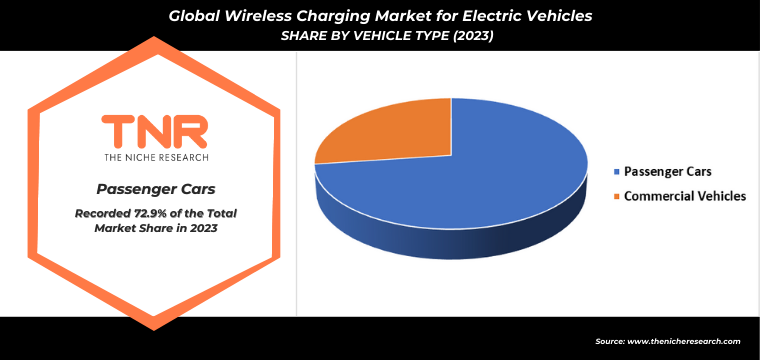
Wireless Charging for Electric Vehicles Market By Installation Type
- Home Charging Units
- Commercial Charging Stations
Home charging units segment dominated the global wireless charging for electric vehicles market with a revenue share of 76.5% in 2023 due to the growing preference for at-home charging solutions, driven by the convenience and ease they offer to EV owners. As more consumers invest in electric vehicles, the demand for efficient and reliable home charging infrastructure has surged. Additionally, advancements in wireless charging technology have made it more accessible and user-friendly, further solidifying its position as the preferred choice for residential charging.
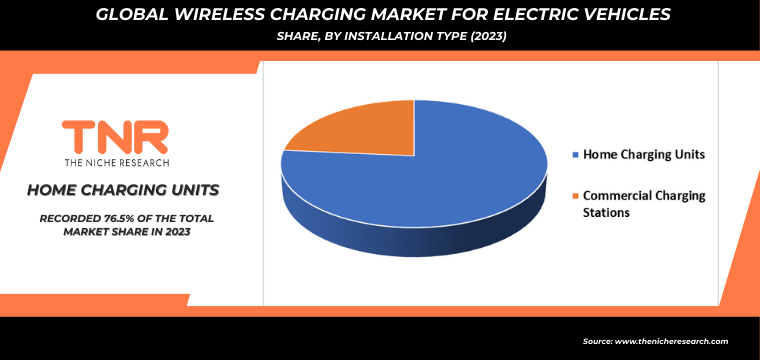
Wireless Charging for Electric Vehicles Market By Power Supply
- 3–<11 Kw
- 11–50 Kw
- >50 Kw
11–50 Kw power supply is set to grow fastest over the forecast timeline in global wireless charging for electric vehicles market due toits balance between charging speed and efficiency. This power range is ideal for public and commercial charging stations, offering quicker top-ups compared to lower power options. As demand for faster, more convenient charging solutions increases, especially in urban areas, the adoption of this segment is expected to rise significantly.
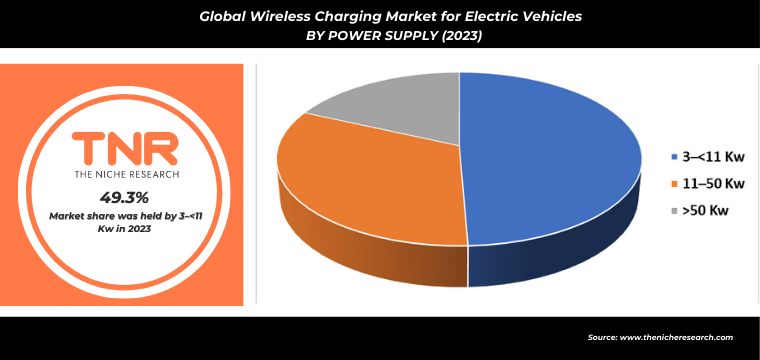
Wireless Charging for Electric Vehicles Market By Region
- North America (U.S., Canada, Mexico, Rest of North America)
- Europe (France, The UK, Spain, Germany, Italy, Nordic Countries (Denmark, Finland, Iceland, Sweden, Norway), Benelux Union (Belgium, The Netherlands, Luxembourg), Rest of Europe)
- Asia Pacific (China, Japan, India, New Zealand, Australia, South Korea, Southeast Asia (Indonesia, Thailand, Malaysia, Singapore, Rest of Southeast Asia), Rest of Asia Pacific)
- Middle East & Africa (Saudi Arabia, UAE, Egypt, Kuwait, South Africa, Rest of Middle East & Africa)
- Latin America (Brazil, Argentina, Rest of Latin America)
Asia Pacific is projected to be the fastest-growing region in the wireless charging for electric vehicles market during the forecast period, driven by the rapid adoption of electric vehicles in countries like China, Japan, and South Korea. Strong government support, including subsidies and incentives for EVs, coupled with significant investments in charging infrastructure, are key factors propelling growth. Additionally, the presence of major automotive manufacturers and technology companies in the region is fostering innovation and accelerating the deployment of wireless charging solutions.
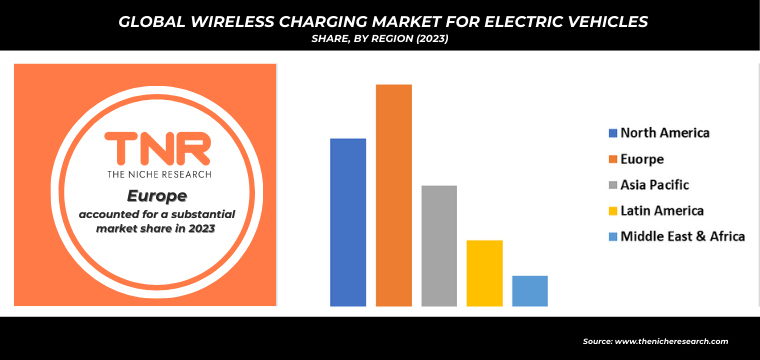
Competitive Landscape
The competitive landscape of the global wireless charging for electric vehicles market features major players innovating in technology, forming strategic partnerships, and investing in infrastructure to capture growing consumer demand and market share.
Some of the players operating in the wireless charging for electric vehicles market are
- Continental AG
- HELLA GmbH & Co. KGaA
- Momentum Dynamics Corporation
- Robert Bosch GmbH
- Tesla
- TGOOD Global Ltd.
- Toshiba Corporation
- Toyota Motor Corporation
- WiTricity Corporation
- ZTE Corporation
- Other Industry Participants
Global Wireless Charging for Electric Vehicles Market Scope
| Report Specifications | Details |
| Market Revenue in 2023 | US$ 83.7 Mn |
| Market Size Forecast by 2034 | US$ 6954.5 Mn |
| Growth Rate (CAGR) | 49.5% |
| Historic Data | 2016 – 2022 |
| Base Year for Estimation | 2023 |
| Forecast Period | 2024 – 2034 |
| Report Inclusions | Market Size & Estimates, Market Dynamics, Competitive Scenario, Trends, Growth Factors, Market Determinants, Key Investment Segmentation, Product/Service/Solutions Benchmarking |
| Segments Covered | By Component, By Propulsion Type, By Charging Type, By Vehicle Type, By Installation Type, By Power Supply, By Region |
| Regions Covered | North America, Europe, Asia Pacific, Middle East & Africa, Latin America |
| Countries Covered | U.S., Canada, Mexico, Rest of North America, France, The UK, Spain, Germany, Italy, Nordic Countries (Denmark, Finland, Iceland, Sweden, Norway), Benelux Union (Belgium, The Netherlands, Luxembourg), Rest of Europe, China, Japan, India, New Zealand, Australia, South Korea, Southeast Asia (Indonesia, Thailand, Malaysia, Singapore, Rest of Southeast Asia), Rest of Asia Pacific, Saudi Arabia, UAE, Egypt, Kuwait, South Africa, Rest of Middle East & Africa, Brazil, Argentina, Rest of Latin America |
| Key Players | Continental AG, HELLA GmbH & Co. KGaA, Momentum Dynamics Corporation, Robert Bosch GmbH, Tesla, TGOOD Global Ltd., Toshiba Corporation, Toyota Motor Corporation, WiTricity Corporation, ZTE Corporation |
| Customization Scope | Customization allows for the inclusion/modification of content pertaining to geographical regions, countries, and specific market segments. |
| Pricing & Procurement Options | Explore purchase options tailored to your specific research requirements |
| Contact Details | Consult With Our Expert
Japan (Toll-Free): +81 663-386-8111 South Korea (Toll-Free): +82-808- 703-126 Saudi Arabia (Toll-Free): +966 800-850-1643 United Kingdom: +44 753-710-5080 United States: +1 302-232-5106 E-mail: askanexpert@thenicheresearch.com
|
Report Layout:
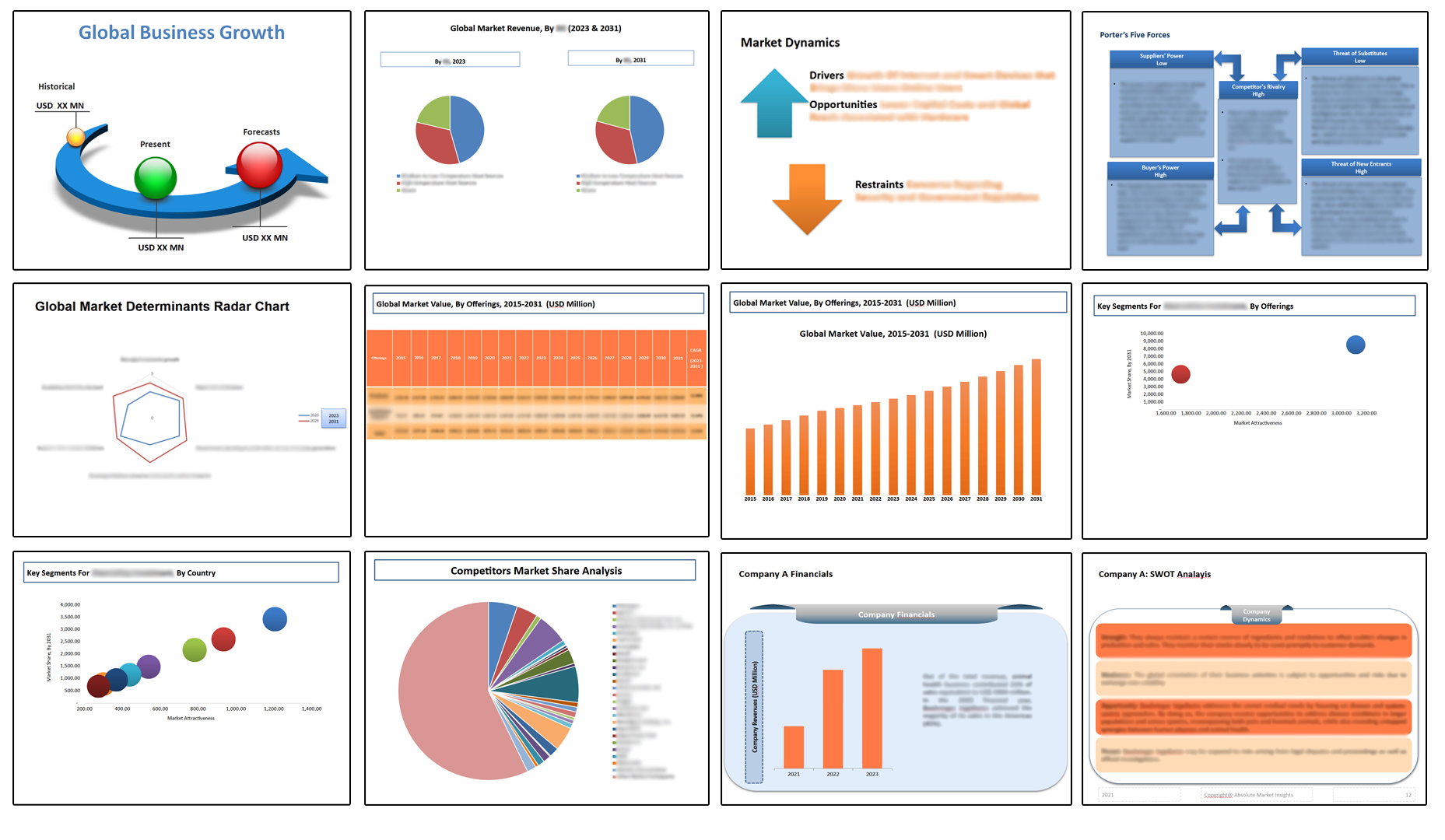
Table of Contents
**Exclusive for Multi-User and Enterprise User.
Global Wireless Charging for Electric Vehicles Market
By Component
- Base Pads
- Vehicle Pads
- Control Units
- Power Control Units
By Propulsion Type
- Battery Electric Vehicles (BEVs)
- Plug-in Hybrid Electric Vehicles (PHEVs)
By Charging Type
- Stationary Wireless Charging
- Dynamic Wireless Charging
By Vehicle Type
- Passenger Cars
- Commercial Vehicles
By Installation Type
- Home Charging Units
- Commercial Charging Stations
By Power Supply
- 3–<11 Kw
- 11–50 Kw
- >50 Kw
By Region
- North America (U.S., Canada, Mexico, Rest of North America)
- Europe (France, The UK, Spain, Germany, Italy, Nordic Countries (Denmark, Finland, Iceland, Sweden, Norway), Benelux Union (Belgium, The Netherlands, Luxembourg), Rest of Europe)
- Asia Pacific (China, Japan, India, New Zealand, Australia, South Korea, Southeast Asia (Indonesia, Thailand, Malaysia, Singapore, Rest of Southeast Asia), Rest of Asia Pacific)
- Middle East & Africa (Saudi Arabia, UAE, Egypt, Kuwait, South Africa, Rest of Middle East & Africa)
- Latin America (Brazil, Argentina, Rest of Latin America)
The Niche Research approach encompasses both primary and secondary research methods to provide comprehensive insights. While primary research is the cornerstone of our studies, we also incorporate secondary research sources such as company annual reports, premium industry databases, press releases, industry journals, and white papers.
Within our primary research, we actively engage with various industry stakeholders, conducting paid interviews and surveys. Our meticulous analysis extends to every market participant in major countries, allowing us to thoroughly examine their portfolios, calculate market shares, and segment revenues.
Our data collection primarily focuses on individual countries within our research scope, enabling us to estimate regional market sizes. Typically, we employ a bottom-up approach, meticulously tracking trends in different countries. We analyze growth drivers, constraints, technological innovations, and opportunities for each country, ultimately arriving at regional figures.Our process begins by examining the growth prospects of each country. Building upon these insights, we project growth and trends for the entire region. Finally, we utilize our proprietary model to refine estimations and forecasts.
Our data validation standards are integral to ensuring the reliability and accuracy of our research findings. Here’s a breakdown of our data validation processes and the stakeholders we engage with during our primary research:
- Supply Side Analysis: We initiate a supply side analysis by directly contacting market participants, through telephonic interviews and questionnaires containing both open-ended and close-ended questions. We gather information on their portfolios, segment revenues, developments, and growth strategies.
- Demand Side Analysis: To gain insights into adoption trends and consumer preferences, we reach out to target customers and users (non-vendors). This information forms a vital part of the qualitative analysis section of our reports, covering market dynamics, adoption trends, consumer behavior, spending patterns, and other related aspects.
- Consultant Insights: We tap into the expertise of our partner consultants from around the world to obtain their unique viewpoints and perspectives. Their insights contribute to a well-rounded understanding of the markets under investigation.
- In-House Validation: To ensure data accuracy and reliability, we conduct cross-validation of data points and information through our in-house team of consultants and utilize advanced data modeling tools for thorough verification.
The forecasts we provide are based on a comprehensive assessment of various factors, including:
- Market Trends and Past Performance (Last Five Years): We accurately analyze market trends and performance data from preceding five years to identify historical patterns and understand the market’s evolution.
- Historical Performance and Growth of Market Participants: We assess the historical performance and growth trajectories of key market participants. This analysis provides insights into the competitive landscape and individual company strategies.
- Market Determinants Impact Analysis (Next Eight Years): We conduct a rigorous analysis of the factors that are projected to influence the market over the next eight years. This includes assessing both internal and external determinants that can shape market dynamics.
- Drivers and Challenges for the Forecast Period:Identify the factors expected to drive market growth during the forecast period, as well as the challenges that the industry may face. This analysis aids in deriving an accurate growth rate projection.
- New Acquisitions, Collaborations, or Partnerships: We keep a close watch on any new acquisitions, collaborations, or partnerships within the industry. These developments can have a significant impact on market dynamics and competitiveness.
- Macro and Micro Factors Analysis:A thorough examination of both macro-level factors (e.g., economic trends, regulatory changes) and micro-level factors (e.g., technological advancements, consumer preferences) that may influence the market during the forecast period.
- End-User Sentiment Analysis: To understand the market from the end-user perspective, we conduct sentiment analysis. This involves assessing the sentiment, preferences, and feedback of the end-users, which can provide valuable insights into market trends.
- Perspective of Primary Participants: Insights gathered directly from primary research participants play a crucial role in shaping our forecasts. Their perspectives and experiences provide valuable qualitative data.
- Year-on-Year Growth Trend: We utilize a year-on-year growth trend based on historical market growth and expected future trends. This helps in formulating our growth projections, aligning them with the market’s historical performance.
Research process adopted by TNR involves multiple stages, including data collection, validation, quality checks, and presentation. It’s crucial that the data and information we provide add value to your existing market understanding and expertise. We have also established partnerships with business consulting, research, and survey organizations across regions and globally to collaborate on regional analysis and data validation, ensuring the highest level of accuracy and reliability in our reports.









